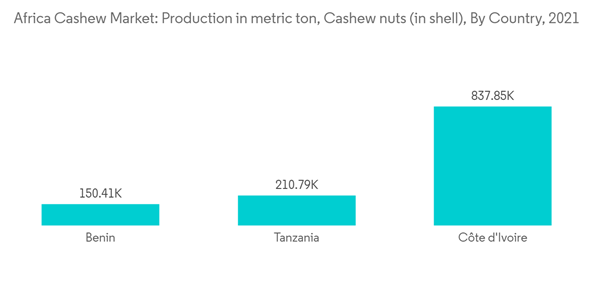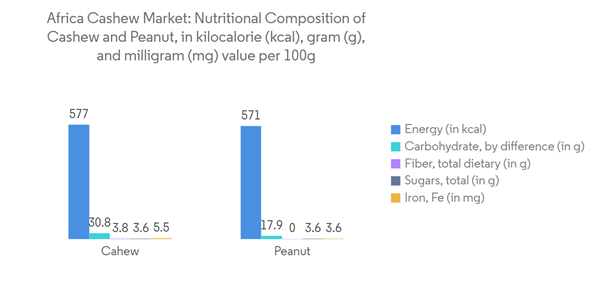Key Highlights
- The African cashew industry has grown rapidly over the last decade. The market's growth is driven by several factors, such as increasing demand for cashew nuts around the region due to their natural nutritional benefits as they are plant-based diets. Cashew nuts are also considered a substitute for dairy products and represent a popular savory snack. They are also a substitute for the ever-popular peanut butter.
- Furthermore, increasing demand for flavored cashews and favorable government initiatives are further fueling the consumption of cashew nuts in the African region. The consumption of cashew kernels, whole or pieces, has had a limited exposition to consumers in West and East Africa. This is attributed to the untapped retail market for ready-to-eat cashews for consumers in the region.
- However, the Competitive Cashew Initiative, formerly known as the African Cashew Initiative, has been playing a vital role in the marketing of high-quality raw cashew kernels in Benin, Côte d'Ivoire, Mozambique, and Ghana, which further enhanced the production and processing efficiencies in these countries in various ways, such as the promotion of SAP software in the cashew value chain in West Ghana.
- Therefore, the high penetration rate of cashew-based retail manufacturers in the markets and the successful implementation of initiatives in cashew production and processing in Africa are further expected to drive the market during the forecast period.
Africa Cashew Market Trends
Côte d’Ivoire Leads the Cashew Market
- Côte d'Ivoire is the country leading the African cashew market, followed by Tanzania, Benin, and Nigeria respectively in the year 2021. It has been experiencing a continuous increase in the production of cashews for the past few years. According to Food and Agriculture Organization (FAO), the production of cashew nuts in Côte d'Ivoire grew from 634,631 metric ton in 2019 to 837,850 metric ton in 2021.
- An average cashew plant starts bearing fruits 4-5 years after plantation, and its productivity tends to decline after 15 years. In Côte d'Ivoire, most cashew trees are relatively young with higher yields, with more than 10% of the acreage being less than ten years old. The acreage is further expanding, with improved and advanced varieties being planted yearly. Due to higher production, Côte d'Ivoire is also Africa's highest exporter of cashews.
- Furthermore, the country's government continuously invests to increase local production and promotes national cashew processing, agreed with businesses in the sector to support the construction of a local value chain, introduced tax incentives, etc. For instance, in 2022, the country's government planned to commit more than USD 20 million to help cashew processors struggling against competition from Asia and boost the percentage of the crop processed in the country.
- Likewise, the World Bank and International Monetary Fund (IMF) investments support Côte d'Ivoire, for cashew production. In recent years, more investments helped start processing centers in Bondoukou, Korhogo, Bouaké, Yamoussoukro, and Abidjan. Thus, the government's strong support for increasing the country's processing capacity through various schemes and incentives is boosting production.
Growing Trend for Healthy Cashew Snacks
- Edible cashew kernels have been used as a snack for many years and are also used as one of the main ingredients in sweets and cooking. Cashews in Africa are increasingly used as a constituent in muesli, energy bars, cookies, chocolates, and ice creams. Cashews are known to be high in nutrients, such as copper, which improve bone health in humans, as one ounce of cashew contains 622 micrograms of copper.
- Guinea-Bissau has been reported to have one of the largest bakers who use cashews to manufacture cashew cookies, nougats, and sweets, fueling the consumption of cashews in the country.
- In Ivory Coast, the Conseil du coton et de l'Anacarde (CCA) is a parastatal organization that organized a conference, the International Cashew Equipment and Technology Show (SIETTA), to encourage local consumption of cashew products and promote cashew processing equipment and technologies to domestic and international investors. CCA is likely to influence the demand for cashews in the country.
- Cashews are relatively high in fiber compared to peanuts, and they help you gain a healthy weight by improving digestive function. The nutritional benefits also extend to the high iron and magnesium content in cashews compared to peanuts, which enhances the enzymatic reactions in the body. Such high-value nutrition in cashews has prompted snack manufacturers to launch several cashew-based snacks to meet the demand, such as ready-to-drink cashew milk, which acts as a lactose-free milk substitute.
- In addition, cashews are high in monounsaturated and polyunsaturated fats and are a good source of protein. The rich fat content of cashews makes them a seamless substitute for heavy cream, as they are increasingly used in a variety of sweet or savory dishes as a healthy vegan alternative to heavy whipping cream.
Africa Cashew Industry Overview
Additional Benefits:
- The market estimate (ME) sheet in Excel format
- 3 months of analyst support
This product will be delivered within 2 business days.










